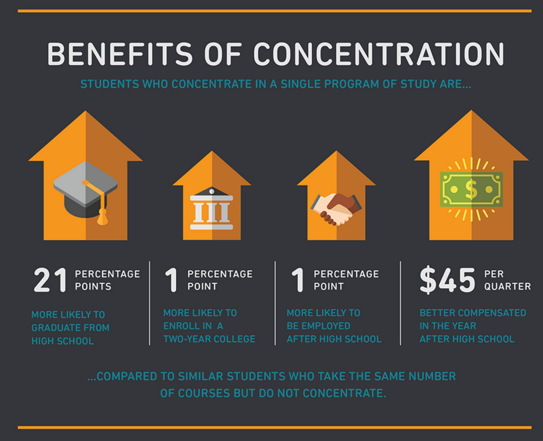In Part II, we dive into the Thomas B. Fordham Institute’s newest report, “Career and Technical Education in High School: Does It Improve Student Outcomes?†Provocative title notwithstanding, the report’s short answer is: Yes.
The report opens with a caveat that CTE is not a meaningful prat of students’ high school experience, and unlike most industrialized countries, it has been chronically neglected by leaders and policymakers.
“American students face a double-whammy: Not only do they lack access to high-quality secondary CTE, but then they are subject to a ‘bachelor’s degree or bust’ mentality,†the report states. “And many do bust, dropping out of college with no degree, no work skills, no work experience and a fair amount of debt.â€
But according to data examined by University of Connecticut’s Shaun M. Dougherty, students do benefit from CTE coursework, in particular those course sequences aligned to certain industries. Based on the report’s findings, it calls for policymakers and education leaders across the country to invest more heavily – and strategically – in high school CTE, and to reauthorize the Carl D. Perkins CTE Act and increase federal support for high-quality, labor market-aligned programs that are available and appealing to all students.
The report’s findings will be discussed on April 14 in Washington, DC, and will also be streamed. Register here to hear from the report’s author and Arkansas State CTE Director Charisse Childers, among others.  The study uses the wealth of secondary, postsecondary and labor market data from the Arkansas Research Center to better understand the state of CTE, both of those students who take CTE courses and those who take three or more CTE courses within a career field.
Key findings include:
- Students with greater CTE exposure are more likely to graduate from high school, enroll in a two-year college, be employed and earn higher wages.
- CTE students are just as likely to pursue a four-year degree as their peers. There was little evidence of “tracking.â€
- The more CTE courses students take, the better their education and labor market outcomes. Among other positive outcomes, CTE concentrators are more likely to graduate high school by 21 percentage points when compared to otherwise similar students.
- Though white and female students are more likely to concentrate, CTE provides the greatest boost to students who need it most – males and students from low-income families.
The report offers recommendations similar to what has taken place in Arkansas:
- Examine state labor market projections to identify high-growth industries
- Offer CTE courses aligned to skills and industry-recognized credentials in these fields and encourage (or require) high school students to take them)
- Encourage (or require) students take a concentration of CTE courses
- Support and encourage dual enrollment and make credits “stackable†from high school into college, so that high school CTE courses count toward specific postsecondary credentials
Andrea Zimmermann, State Policy Associate




